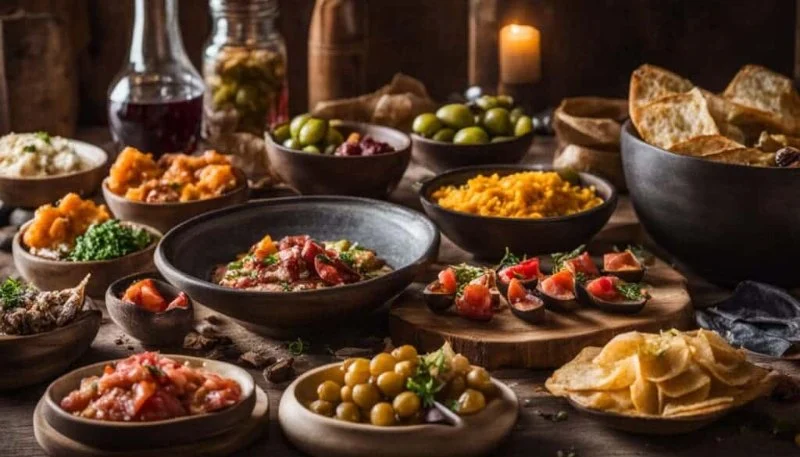
- - 1. What Makes Spanish Tapas Unique?
- - 2. Regional Variations in Tapas Across Spain
- - 3. Popular Spanish Tapas Recipes to Try at Home
- - 4. The Cultural Significance of Tapas in Spain
- - 5. Tips for Perfecting Tapas at Home
1. What Makes Spanish Tapas Unique?
Tapas, small savory dishes or snacks, are a cornerstone of Spanish cuisine, embodying the country’s food culture. Whether served as appetizers or enjoyed in a social setting with drinks, tapas have a long-standing tradition in Spain. What makes tapas truly unique is their ability to represent the flavors and ingredients of different Spanish regions, each with its distinct twist on the classic concept of tapas.
While tapas can vary greatly in terms of ingredients and preparation, they share a common characteristic: they are designed for sharing and socializing. Whether it’s a simple plate of olives or a more complex dish like albondigas (meatballs in sauce), tapas bring people together to enjoy the best of Spanish culinary traditions in a relaxed and enjoyable way.
2. Regional Variations in Tapas Across Spain
One of the most fascinating aspects of Spanish tapas is how they vary by region. Each part of Spain has developed its own take on tapas, often using locally sourced ingredients that reflect the area’s culture and history. Here’s a quick tour of some of Spain’s regional tapas specialties:
- Andalusia: Known for its fried seafood, Andalusia offers dishes like pescaíto frito (fried fish), where small fish like anchovies are battered and fried to perfection. Another classic is jamón ibérico, a dry-cured ham from the region that’s an essential part of tapas culture.
- Catalonia: In the north-east, Catalonia is famous for montaditos—small sandwiches that can be topped with anything from cured meats to seafood. Escudella i Carn d’Olla, a hearty Catalan stew, can also be found served as a tapas-sized portion in some places.
- Madrid: Madrid's tapas often include callos a la madrileña (a tripe stew) and tortilla española (Spanish omelette), both popular comfort foods that make for satisfying tapas dishes.
- Basque Country: Tapas in the Basque region often come in the form of pintxos—small skewers or slices of bread topped with an assortment of toppings such as marinated anchovies, grilled vegetables, or chorizo.
- Valencia: Tapas from Valencia often feature fresh seafood, particularly arroz a banda, a rice dish typically served as a tapa. The region is also known for its tapas de paella, where small portions of the famous paella are served as tapas.
3. Popular Spanish Tapas Recipes to Try at Home
If you’re eager to bring the flavors of Spain into your kitchen, here are a few regional tapas recipes you can easily make at home:
How to Make Andalusian Pescaíto Frito
- Start with small fish like anchovies or sardines, cleaned and deboned.
- Coat the fish in a mixture of flour, salt, and pepper, shaking off the excess.
- Heat a generous amount of olive oil in a frying pan over medium heat.
- Fry the fish until golden and crispy, about 2-3 minutes on each side.
- Serve hot with a squeeze of lemon juice and a side of aioli or a simple dipping sauce.
How to Make Catalonian Montaditos
- Start with a crusty loaf of baguette or ciabatta, cutting it into small slices.
- Top each slice with a variety of ingredients like smoked salmon, grilled vegetables, or paté.
- Toast the montaditos in the oven for a few minutes until the bread is crispy.
- Serve warm with a drizzle of olive oil and a sprinkle of sea salt for added flavor.
4. The Cultural Significance of Tapas in Spain
Tapas are more than just food in Spain—they’re an integral part of the social and cultural fabric of the country. The tradition of enjoying tapas has its roots in Andalusia, where it is said that tapas were originally served with drinks to encourage people to stay longer in bars and socialize.
Today, tapas are enjoyed throughout Spain, with people often spending hours in the evening going from bar to bar, sampling different tapas and chatting with friends. The custom of sharing food fosters a sense of community and hospitality, making tapas an essential experience for anyone visiting Spain.
5. Tips for Perfecting Tapas at Home
If you want to create an authentic tapas experience at home, here are a few tips to help you perfect your dishes:
- Use high-quality ingredients: Authentic Spanish tapas rely on fresh, high-quality ingredients like cured meats, seafood, and olive oil. Make sure to use the best products available for the most flavorful results.
- Don’t overcomplicate it: Many tapas are simple and rely on the quality of the ingredients. Focus on perfecting a few dishes rather than overwhelming yourself with too many options.
- Pair with Spanish wines or sherry: Tapas are traditionally paired with wine or sherry, making for a more complete and enjoyable experience.
- Serve in small portions: The beauty of tapas lies in their small size, so ensure that you serve them in bite-sized portions, allowing your guests to sample a variety of flavors.
By exploring regional tapas recipes, you can not only discover the diverse culinary traditions of Spain but also recreate authentic Spanish flavors in your own kitchen. Whether you're enjoying pescaíto frito from Andalusia or montaditos from Catalonia, each bite will transport you to the heart of Spain.









 Tap & Tapas4.0 (84 reviews)
Tap & Tapas4.0 (84 reviews) Spanish Island Foods4.0 (97 reviews)
Spanish Island Foods4.0 (97 reviews) Nano's NJ4.0 (96 reviews)
Nano's NJ4.0 (96 reviews) Spanish Food Restaurant4.0 (47 reviews)
Spanish Food Restaurant4.0 (47 reviews) Las Fronteras4.0 (11 reviews)
Las Fronteras4.0 (11 reviews) Las Palmas Deli4.0 (225 reviews)
Las Palmas Deli4.0 (225 reviews) How to Make Spanish Migas con Chorizo y Huevos: Traditional Bread, Sausage, and Egg Dish
How to Make Spanish Migas con Chorizo y Huevos: Traditional Bread, Sausage, and Egg Dish How to Make Spanish Tarta de Naranja: Orange Cake Recipe
How to Make Spanish Tarta de Naranja: Orange Cake Recipe How to Make Authentic Spanish Paella at Home
How to Make Authentic Spanish Paella at Home How to Make Spanish Tarta de Fresas: Delicious Strawberry Cake Recipe
How to Make Spanish Tarta de Fresas: Delicious Strawberry Cake Recipe Exploring the Best Spanish Seafood Dishes to Try at Home
Exploring the Best Spanish Seafood Dishes to Try at Home How to Make Spanish Piquillos Rellenos: Stuffed Peppers Recipe
How to Make Spanish Piquillos Rellenos: Stuffed Peppers Recipe